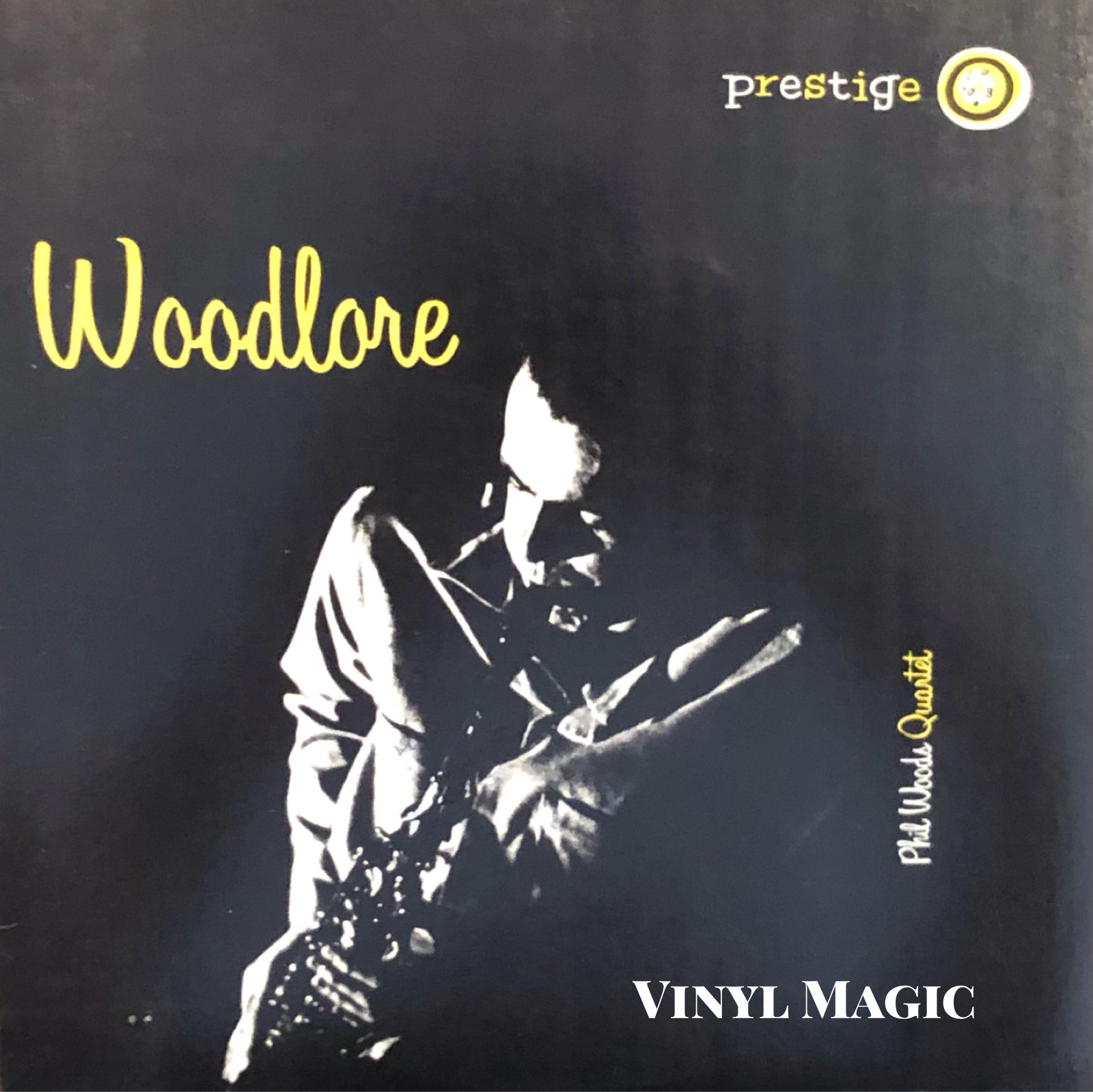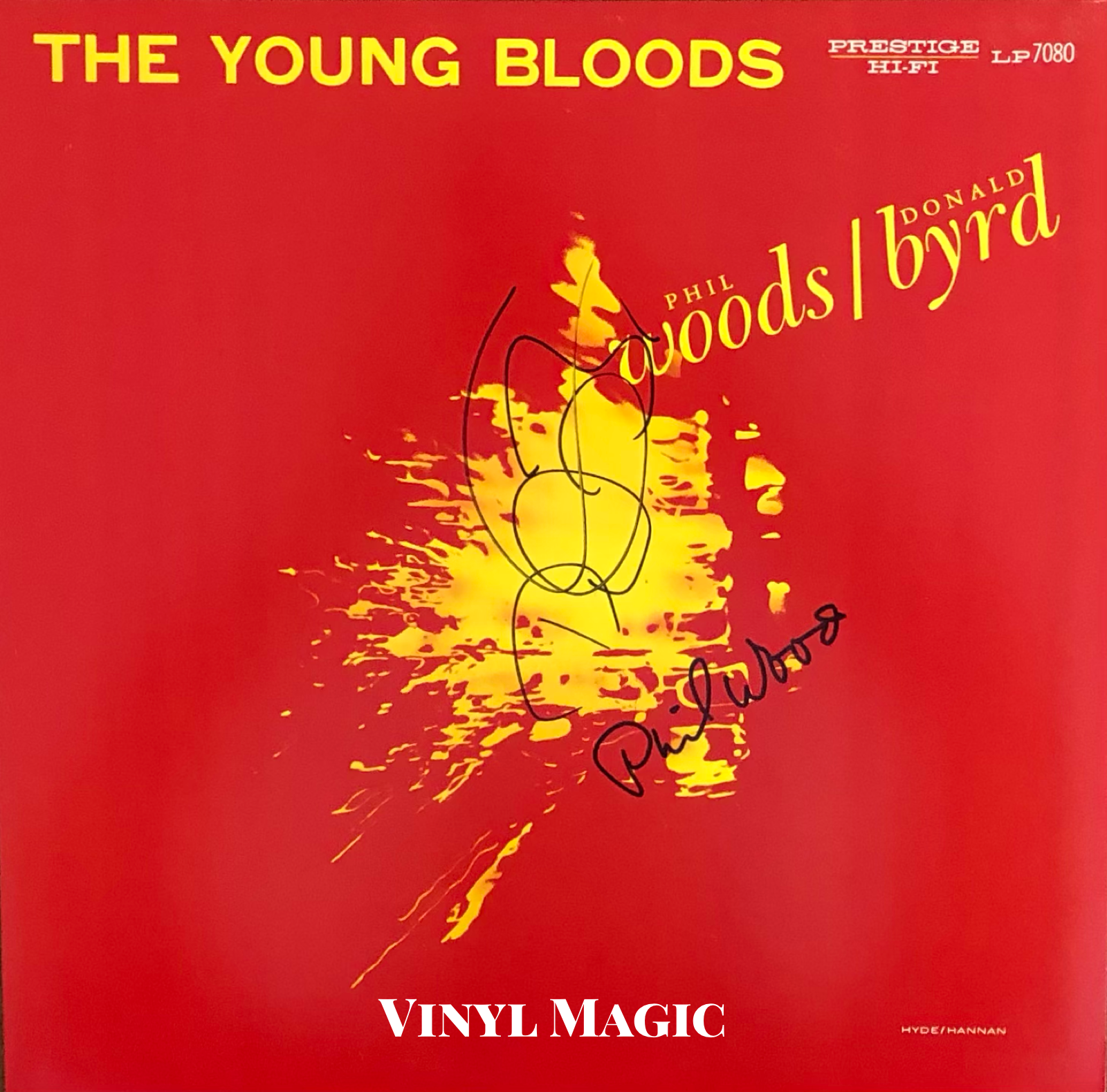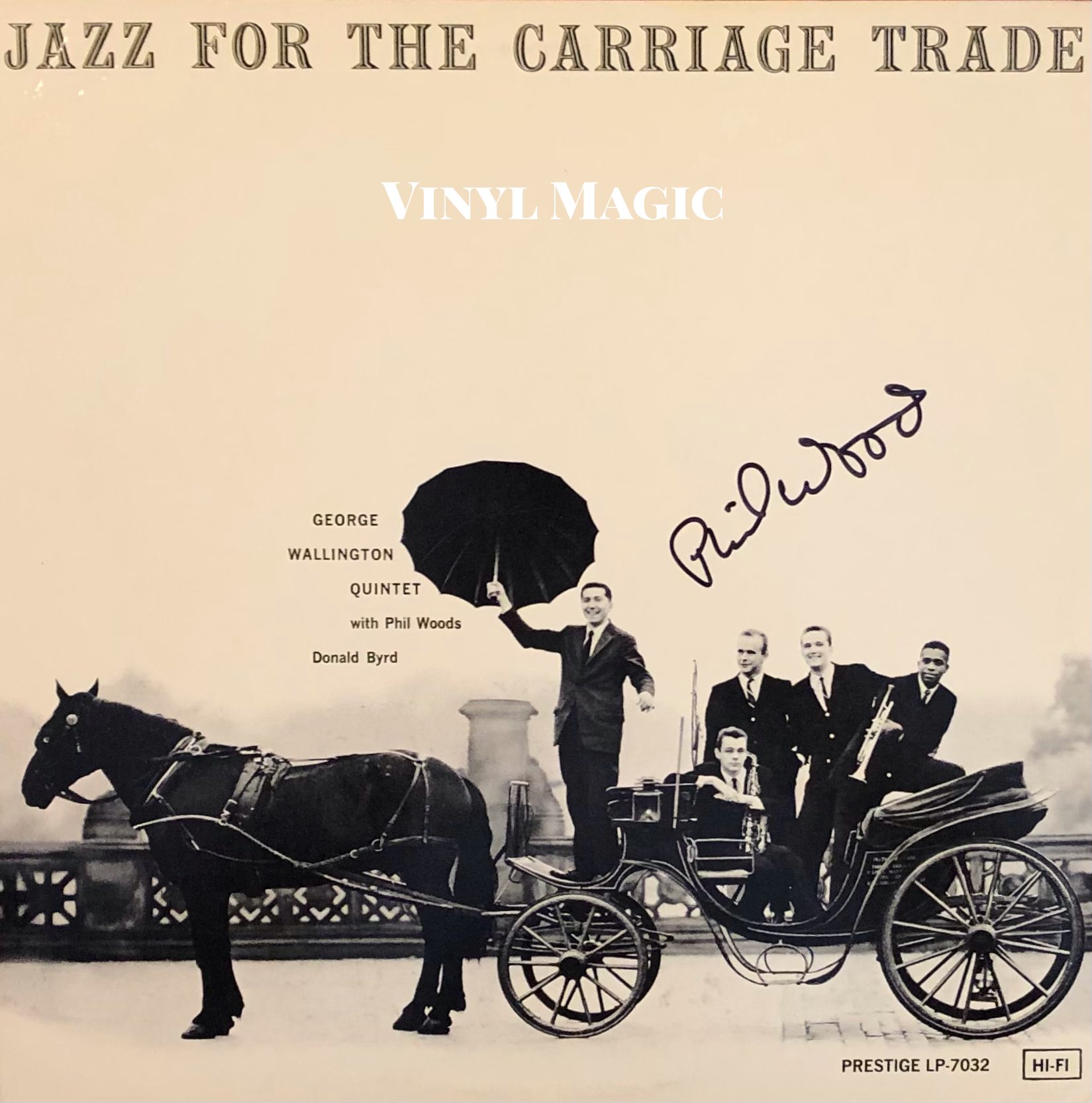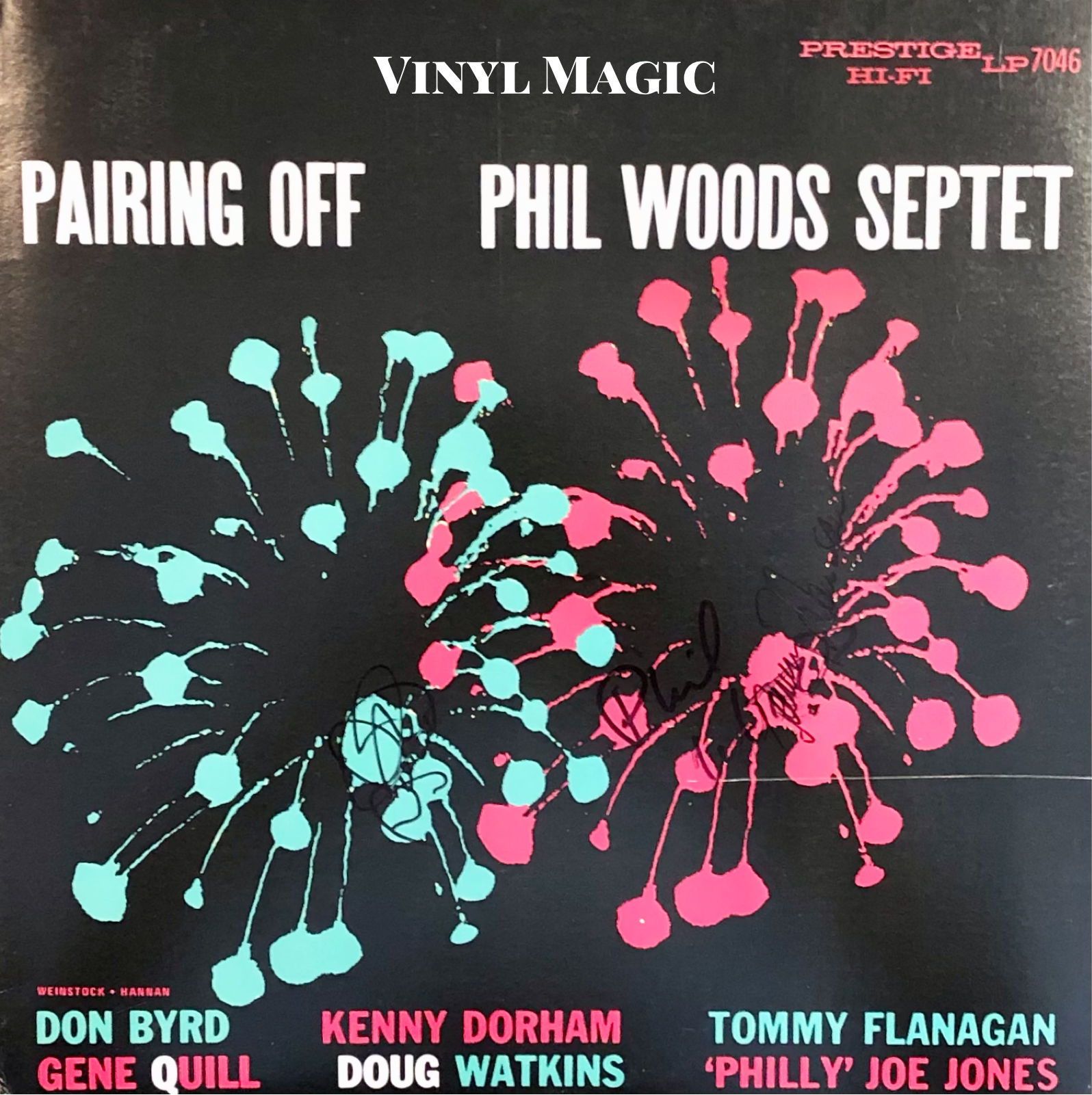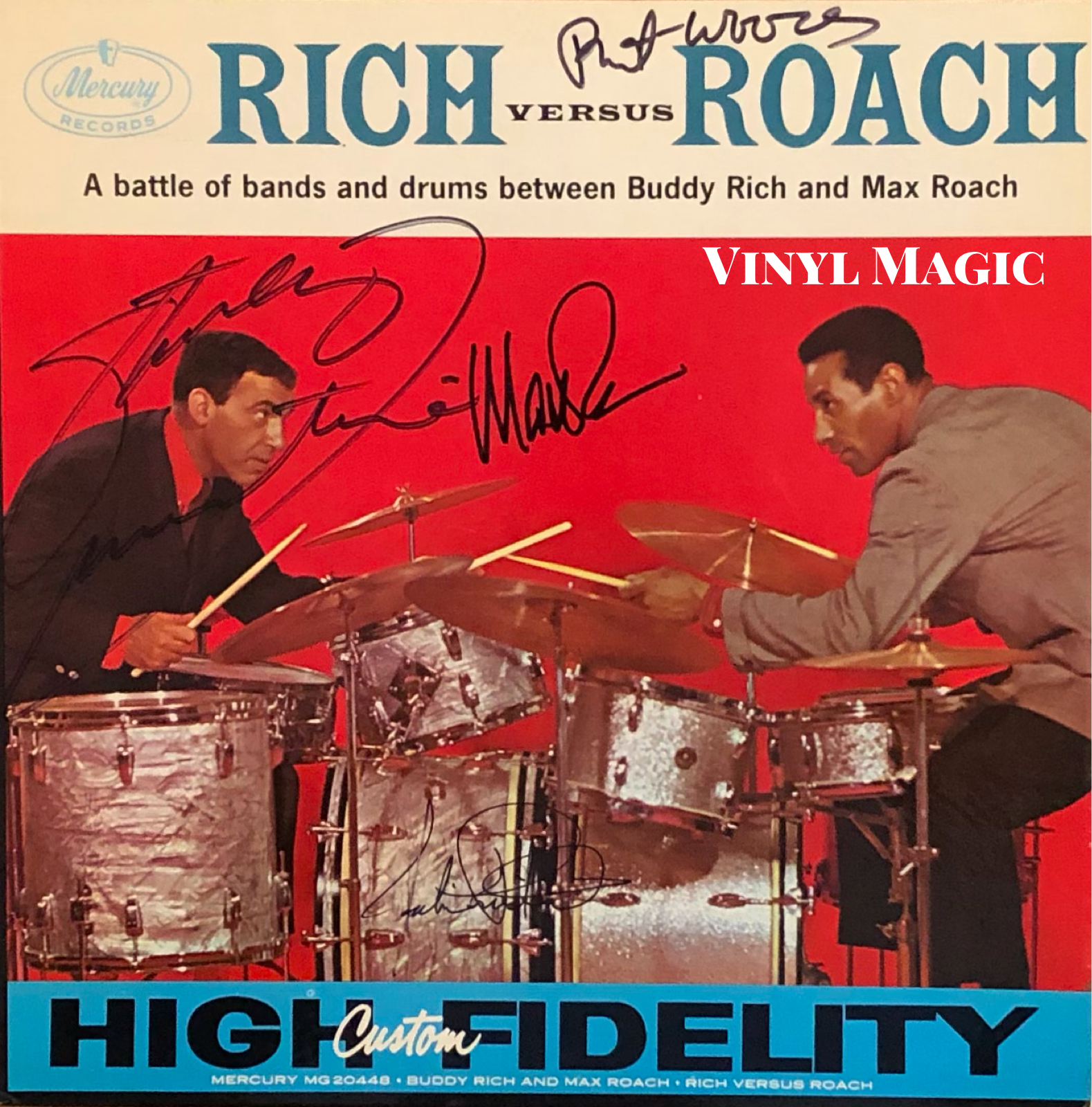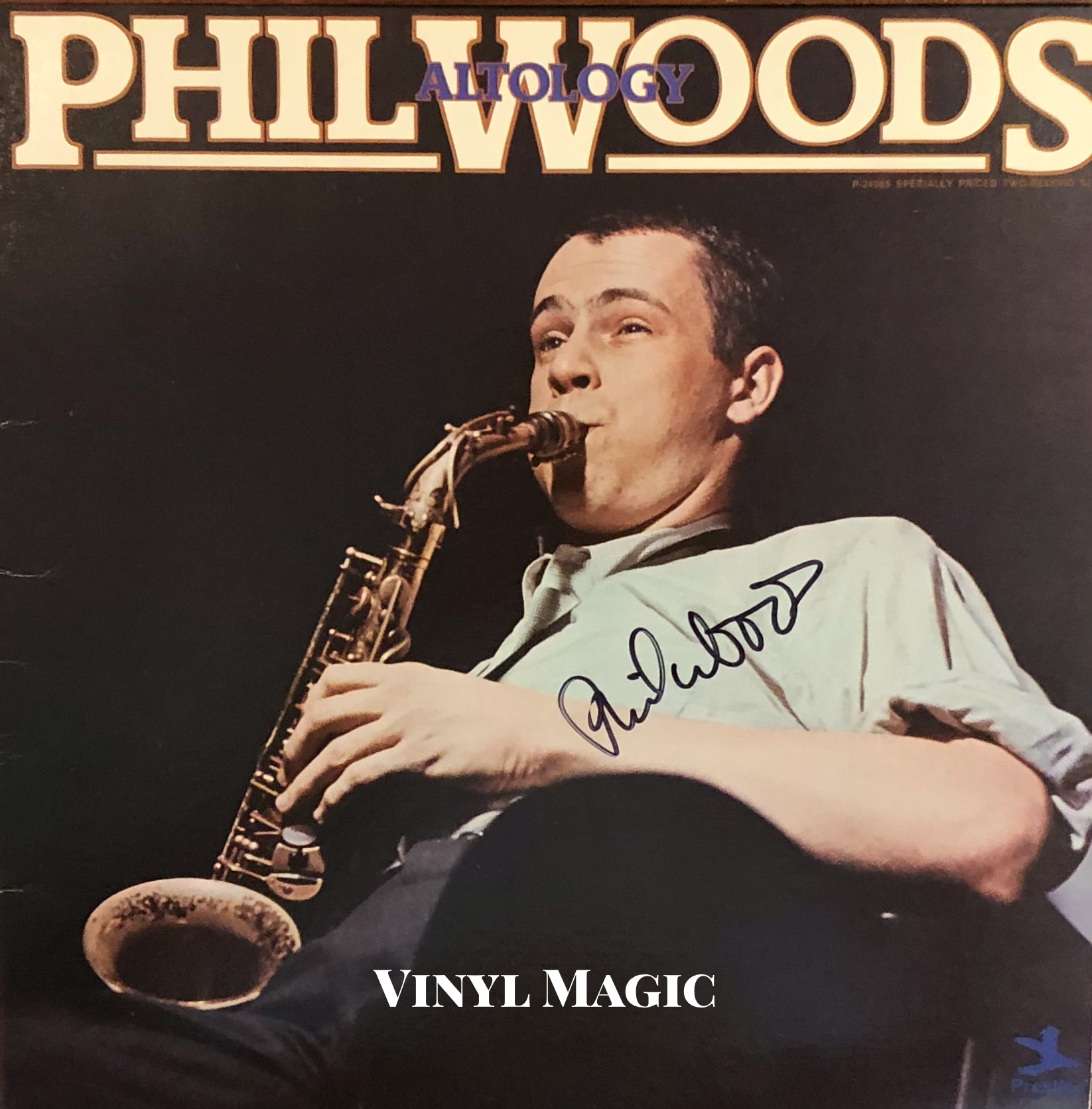Phil Woods, Charlie Parker and Me…
As a musician, I’m trying to touch people. If that works, great. I can’t tell you what makes that work. I have a thing on my wall here that Beethoven said: "The vibrations on the air are the breath of God speaking to man's soul. Music is the language of God. We musicians are as close to God as man can be. We hear his voice, we read his lips, we give birth to the children of God, who sing his praise. That’s what musicians are." I love that.
Phil Woods
Phil & Quill (1957) signed by Phil
The Lennie Tristano Trio opened, and when they were through, his bassist, Arnold Fishkind, came to get us. Lennie was blind, of course, so Arnold and Lennie took us behind the curtain—the place was a former speakeasy and too small for a true backstage area. There sitting on the floor was the great Charlie Parker....eating a cherry pie. He said, “Hey kids, you want a piece of cherry pie?” I said, 'Oh Mr. Parker, cherry is my favorite flavor.' And it was. I’ve always loved cherry pie, so he cut me a big slab, and we talked music. We were there for about five or ten minutes, then he had to go to work. He had his pie, and then the lesson started. We went back outside and listened to an hour of the genius of the alto saxophone.
Phil Woods meeting Charlie Parker for the first time in 1946
Woodlore (1957) signed by Phil
We no sooner landed than Frank Rehak, who was a pretty wild guy, got right to the opium den and he came back with some of the best smoke... so it’s the first rehearsal, I’d never met Dizzy, and we’re rehearsing in Abardan, Iran, and it’s outdoors, there’s no dressing rooms, it’s just a little stage. And then... Frank brought some of his goodies and we’re underneath the stage and a pipe is going, being passed around. And all of a sudden, everybody disappears and I’m holding the pipe, and here comes Dizzy, and he says “What do you got there?” And I said, 'It’s not my pipe.' "Yeah, that’s good, that’s a good line, Phil. That’ll get you off the hook," he says, “Young man, do you realize this is a State Department tour?” I say 'Yeah.' He says, “You could be jeopardizing my gig, every man, jack on the band, I mean it could be the end of detente, the end of world peace.” He had me going. I knew I was going to get sent home. He gave me like about ten minutes of this tirade, then he says, “Is it any good?” I said, 'Birks, I’m no expert but it’s the best grass I ever smoked.' And he said, “Then gimme me some before I fire your white ass.”
Phil Woods meeting his new boss Dizzy Gillespie in Iran in 1956
The Youngbloods (1956) signed by Phil, Donald Byrd
I had just graduated from Juilliard in 1952 and was playing at the Nut Club on Seventh Avenue and Sheridan Square in the Village. After all of that great education, here I was playing Harlem Nocturne ten times a night. I wasn’t happy with myself. I was saying to myself, My God, I’m a Juilliard graduate, and I can play great jazz, and here I am playing Night Train and Harlem Nocturne. I didn’t like my mouthpiece. I didn’t like my reed. I didn’t like my horn. I didn’t even like the strap. One night somebody came into the club and said, “Hey, Charlie Parker’s playing across the street, he’s jamming.” The guy was referring to Arthur’s Tavern... it was a little tiny hole in the wall with a little bar. I was going on my break so I rushed over... and there was the great Charlie Parker playing the baritone sax. It belonged to Larry Rivers, the painter. Parker knew me. He knew all the kids who were coming up. I said, 'Mr. Parker, perhaps you’d like to play my alto?' He said, “Phil, that would be great. This baritone’s kicking my butt.” So I ran back across the street to the Nut Club and grabbed the alto sax that I hated. I came back and got on the bandstand, which was about as big as a coffee table. I handed my horn to Bird and he played Long Ago and Far Away. As I’m listening to him play my horn, I’m realizing there’s nothing wrong with it. Nothing was wrong with the reed, nothing was wrong with the mouthpiece, even the strap sounded good. Then Parker says to me, “Now you play.” I said to myself, 'My God.' So I did, I played a chorus for him. As soon as Bird finished, he handed me the horn to take my solo. When I was done, Bird leaned over and said, “Sounds real good, Phil.” This time I levitated over Seventh Avenue to the Nut Club, and when I got back on the bandstand there, I played the shit out of Harlem Nocturne. That’s when I stopped complaining and started practicing. That was quite a lesson.
Phil Woods
Jazz For The Carriage Trade (1956) signed by Phil
Quincy Jones had a band that was preparing to tour Europe in the summer of 1959. The band was rehearsing in the mezzanine of the Olympia Theatre and I somehow wrangled an invitation to attend a rehearsal. It was a great band with some of Quincy's friends from Seattle... I listened to a number of pieces in which there were solos played by various members of the band. It would be unfair to say that those solos were perfunctory, but later, when Phil Woods stood up from the lead alto chair to play his solo feature, the atmosphere changed. Phil played as if there were no tomorrow. The contrast was striking and I have always remembered the impression it left. If you practice rehearsing, then when the time comes to perform, you are ready to rehearse. Phil practiced performing.
bassist Chuck Israels
Bird Feathers (1957) signed by Phil, Jackie McLean
They (Art Blakey and Dizzy Gillespie) kidnapped me... cause I was in a maudlin groove.I was drinking too much, I was not content with my existence, I was not making any progress. And so they threw me in a cab and took me to Dizzy’s house. And they said, What’s your problem?” And I said, 'Oh man, I’m just not getting anywhere.' And they said, “Well, if you clean up your act a little bit, stop drinking so much, you might be somebody.” I said, 'You think I can play?' They said, “Yeah you can play, but you’ve been behaving like an asshole." I said, 'Yeah, but I’m a white guy.' And Dizzy said, “Time out. big time out here. Woods, Charlie Parker didn't play this music for black people, or for red people, or for green people. He played it for everybody. If you can hear it, you can have it. You know, you can't steal a gift. Bird gave it to us, you can't steal a gift." I never forgot that night...and it changed my life. I stopped drinking in excess, I mean, I didn't become perfect, but I went up another notch...
Phil Woods
Pairing Off (1956) signed by Phil, Donald Byrd, Tommy Flanagan
The pride of Springfield, Massachusetts, Phil Woods became an important jazz alto saxophonist, composer, arranger and teacher during his nearly sixty year recording career. He released more than fifty-five albums as a leader and performed on hundreds more vinyl as a sideman with Bill Evans, Dizzy Gillespie, Thelonious Monk and so many others. Few artists, if any, studied with blind jazz pianist Lennie Tristano, graduated from the Juilliard School of Music, jammed with Charlie Parker (even marrying his widow Chan Parker for seventeen years!), and played on studio tracks with Billy Joel ("Just The Way You Are"), Aretha Franklin ("Somewhere"), Paul Simon ("Have A Good Time") and Steely Dan ("Dr. Wu"). Yes, Phil Woods is unique in his improbable life and singular career.
Rich versus Roach (1959) signed by Phil, Max Roach, Stanley Turrentine
Bequeathed a saxophone by his uncle when he was twelve years old, Phil resisted his initial urge to melt it down into tiny toy soldiers and began to play it. Remarkably, he generated a sweet sound and private lessons followed with Harvey LaRose, a music teacher whom Phil selected indiscriminately from a telephone directory. A simple, random phone call changed his life. Phil remembered, "Your first teacher in anything is so important. If that person decides you have talent and wants to touch your soul, wonderful things can happen. Mr. LaRose was an incredible inspiration. Mr. LaRose was the man." Soon, Phil was playing in the high school jazz band and he began field trips to New York City for additional studies with Lennie Tristano, an influential jazz pianist credited with playing 'free jazz" improvisations for the first time in 1949 with his quartet. Upon graduation from high school at age sixteen, Phil enrolled in The Juilliard School of Music in New York City where he studied the clarinet. A saxophone major was not yet offered in Juilliard's 1940s curriculum as it was not considered rigorous enough or befitting classical instruction, so Phil studied Brahms and Mozart on clarinet during the day and played alto saxophone at bebop jam sessions at night. It was quite an education and experience.
Jazz Sahib (1957) signed by Phil, Hank Jones, Benny Golson
Jazz was vital and booming in the United States in the 1950s, in the dance halls and theaters, on the radio and jukeboxes, and especially at its epicenter, the plentiful jazz clubs of New York City. Phil recalled the scene, "And jazz was in every joint. Jazz was relevant. I mean people were dancing to 'All the Things You Are' and 'How High the Moon.' You’d play your horn and nobody said you were playing art or jazz. You were just playing American music. It was a different world." Phil began to lead his own groups and toured and recorded with Dizzy Gillespie, Buddy Rich and Quincy Jones, all important artists in his development. Phil even participated in a Benny Goodman tour of the Soviet Union during the height of the Cold War. Phil reminisced, "In 1962, I joined Benny Goodman for his tour of Russia. He wasn't the greatest human being that I've ever met, but what a great artist! That's all we really care about, the great art. But he was tough on his musicians and nobody really understands why. He had his set ways, he wanted us to sound like his 1938 band. It was unusual for a man who did so much to revolutionize the music to be caught up in the past like that. If any of us caught the audience for him, he'd reduce our solo space. It was very perverse. I don't think he had always been that way though, I think it was something that caught him in later years. That was the only time I ever worked for him, we'd had quite enough of each other." Phil was not alone in his dislike of Benny. As fellow tour member and tenor sax great Zoot Sims said when asked what it was like to tour Russia with Benny Goodman, "Any tour with Benny Goodman is like being in Russia!"
Altology (1957 recordings, released 1976) signed by Phil
As rock and roll eclipsed the importance of jazz during the 1960s, Phil moved to Paris with his then wife Chan Parker and their children. A souring United States political climate in 1968 provided further impetus, and what jazz musician doesn't love, or isn't beloved in, Paris?! He stayed five years before returning in 1973 and he was miserable and uncertain upon his return: "I stayed in L.A. for a minute before heading back to New York. I was going to head back to Paris. Nothing was happening for me in the States. It was a failed experiment. I was trying to be a prophet in my own land. I was staying with Jerry Dodgion, the saxophonist. We were just kind of hanging out one day and saying goodbye to everybody since I was returning soon for Paris. The phone rang, and it was Michel Legrand’s manager who needed a saxophonist to play with Michel. His manager said, “I got Eddie Daniels just for the first week but I need someone at Jimmy's Club. We’re going to record live, and I need a good man.” Jerry said, “I can’t do it but Phil Woods is sitting right here. Do you want to talk to him?” Well, to make a long story short, I did the gig. That was my solo spot. I had just split up with Chan, I had just fallen in love with Jill, my current wife. She was ill at the time, and I didn’t know what I was doing. I was going out of my head. I had to deal with divorce proceedings, my future wife was sick and I was heading back into the New York clubs with my tail between my legs to record with Michel."
Around The World (1961) signed by Phil, Clark Terry
For the second time, Phil's destiny changed as a result of a phone call. Of all the songs Phil has written and recorded in his lengthy career, he cites "You Must Believe In Spring" from that live recording at Jimmy's Club with Michel Legrand as his pivotal and essential favorite. "It's one of the highlights of our live recording for RCA. When the tape was rolling, I said to myself, 'I’ve got to come up with something here. This is it.' Well, I guess I did because that led to a record contract with RCA. For the next RCA project, Michel wrote a piece called Images that we recorded in London in 1975 with strings. It won a Grammy that year, and the rest is history. I know, it was ironic that I was heading back to France because nothing was happening here, and my career was saved by Michel Legrand, who had lived just down the road from me in Paris. So that song has a lot of importance for me." Indeed, their success led Phil to form his own quintet which would last for the next forty years and achieve four Grammy wins, not to mention the studio work with Aretha Franklin, Billy Joel, Paul Simon and Steely Dan. While Phil was only paid $300 for his studio work on Billy Joel's "Just The Way You Are", he was not bitter. He was bitter about one missed opportunity, "I wish I had done Earth, Wind & Fire, because that's one of my favorite bands. I didn't know who they were and my idiot manager said, "They don't have enough money." I mean, $300 for Billy Joel, that's not a lot of money either, man. Earth Wind & Fire would have paid twice that....it was a mistake. I was misguided by my management, so I never had a manager again."
Phil Woods/Les Tabackin (1981) signed by Phil, Lew, Bill Goodwin
I saw Phil Woods innumerable times over the years in jazz clubs in Washington, DC and New York City. He always had great musicians with him, including his brother-in-law Bill Goodwin on drums, Steve Gilmore on bass, Hal Galper or Bill Charlap on piano and Tom Harrell or Brian Lynch on trumpet. He always wore a leather cap ((http://leather-accessories.net/phil_woods_hat.html - buy it now while supplies last!) and he was of boundless energy on stage. One memorable show was at One Step Down in the West End at the edge of Georgetown in Washington, DC. Singer and pianist Shirley Horn called it "The best little jazz joint", I called it a dive. It was small, maybe a capacity of sixty patrons, and when you entered off Pennsylvania Avenue, you took one step down and walked into the club.The piano was set up to the left, a quintet at most could fit on what passed for a bandstand, and then a long, dark mahogany bar, probably forty feet to the end of the narrow rectangular room with restrooms in the rear. Cloaked in anonymity, One Step Down was a windowless, smoke-filled drinkers hideaway, far from prying eyes. Several brown naugahyde booths fronted the stage, the floor an unholy alliance stained with nicotine, smoke, spilled booze, broken promises and unfulfilled dreams. A perfect dive and an intimate venue for some great jazz with Herb Ellis, Shirley Horn, Lee Konitz, James Moody, and David "Fathead" Newman, just a few of the artists Erin and I saw perform here over the years.
Phil Woods Quartet Volume One (1980) signed by Phil, Steve Gilmore, Bill Goodwin
Each time I met Phil, he was always kind and generous while signing the vinyl. As voluble and electric as he was on stage, he was taciturn and demur off stage. A simple nod as he signed was about all he could muster with me, although he did sign one vinyl "Merry Xmas", caught up in the frolic and revelry of the holiday season! I was always struck by his description of his instrument, "You know, that whole early tradition of the alto saxophone. I mean, if you go to the movies and you hear an alto, somebody’s kissing or somebody’s dying. It’s a very romantic or perilous instrument, you know what I mean? But it always signifies something very deep."
Evolution (1988) “Merry Christmas Phil Woods”
Phil's bond and ties to Charlie Parker were steadfast and inextricably linked, so it was fitting that his last performance was a tribute to Charlie at the Manchester Craftsmen's Guild in Pittsburgh on September 4, 2015, reprising the Charlie Parker With Strings vinyl with members of the Pittsburgh Symphony Orchestra. Though stricken with emphysema, supported by an oxygen tank and confined to a wheelchair, Phil played an engaging set and announced his retirement for health reasons before playing his final number ever, Gerry Mulligan's "Rocker." A fitting coda to a remarkable career, Phil died less than a month later at age eighty-three, but what a wonderful legacy he left. As he stated in a late interview, "Jazz will never perish, it's forever music, and I like to think that my music is somewhere in there and will last, maybe not forever, but may influence others."
Whether romantic or perilous, Phil Woods' music persists. He cuts deep.
The Groovy Sound Of Music (1965) signed by Phil, Gary Burton, Bob Brookmeyer, Steve Swallow, Phil Woods
Big Bad Band Live (1974) signed by Phil, Jimmy Heath, Clark Terry
Choice Phil Woods Cuts (per BK's request)
https://www.youtube.com/watch?v=cnsMlgVEeJ4
"You Must Believe In Spring" Live in Montreal with Michel Legrand 2001
https://www.youtube.com/watch?v=36-z_FZZPSI
"You Must Believe In Spring" Live At Jimmy's 1973 Phil's favorite tune!
https://www.youtube.com/watch?v=YzbS6fxA6ZU
"The Summer Knows" Musique Du Bois 1974
https://www.youtube.com/watch?v=FnsycHk8VBw
"All The Things You Are" Cool Woods 1999
https://www.youtube.com/watch?v=rH_svH2LCwY
"I Remember April" Live with strings Marciac Jazz Festival 2005
https://www.youtube.com/watch?v=5EQzk75s61E
"Superwoman" Live From The Showboat Phil swings Stevie Wonder 1976
https://www.youtube.com/watch?v=FJHfs3d4r-8
"Undecided" Live with Quincy Jones Orchestra, Clark Terry and Phil laying out! 1959
https://www.youtube.com/watch?v=1UyUTP_IucQ
"Au Privave" with Red Garland Sugan Phil swings Charlie Parker! 1957
https://www.youtube.com/watch?v=y0zJaoKTyh8
"The Midnight Sun Will Never Set" I Dig Dancers with Quincy Jones 1960
https://www.youtube.com/watch?v=QLkq0DW3lB0
"Stolen Moments" Alive And Well In Paris 1968
https://www.youtube.com/watch?v=3rVfOcB1v9c
“Man With The Hat" Man With The Hat with Grace Kelly 2011
https://www.youtube.com/watch?v=sdUTVlQqG5M
"Rocker" Re-Birth Of The Cool with Gerry Mulligan 1988
Bonus cuts:
https://www.youtube.com/watch?v=JIr_hAJOv5w
"Somewhere" Hey Now Hey (The Other Side Of The Sky) Aretha sings, Phil swings! 1973
https://www.youtube.com/watch?v=HaA3YZ6QdJU
"Just The Way You Are" The Stranger Billy Joel - Phil wails at the end! 1977
https://www.youtube.com/watch?v=UtEm14zt3Ug
“Have A Good Time" Still Crazy After All These Years Paul Simon - Phil cuts loose at the end! 1975
https://www.youtube.com/watch?v=5fNVzxq81ns
"Dr. Wu" Katy Lied Steely Dan 1977 Phil solos
More Live (1981) signed by Phil
What Makes Sammy Swing! (1964) signed by Phil, Clark Terry
Quincy Jones Explores The Music Of Henry Mancini (1964) signed by Phil, Gary Burton, Clark Terry

